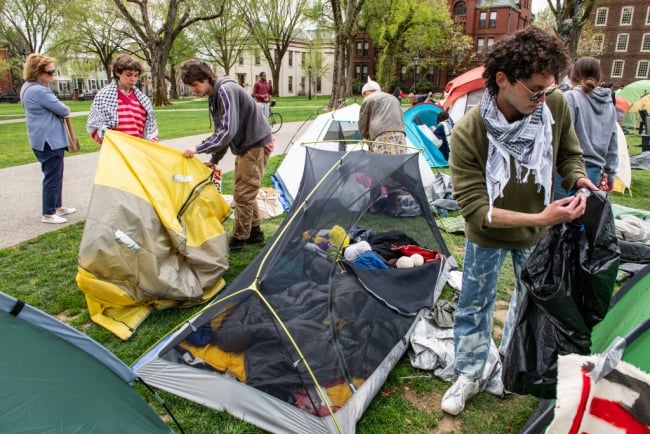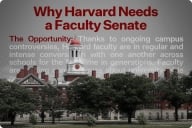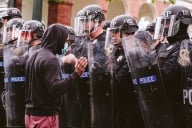You have /5 articles left.
Sign up for a free account or log in.

Students at Brown University dismantled their encampment after reaching an agreement with officials to present a divestment plan to Brown’s governing board.
Joseph Prezioso/AFP via Getty Images.
As pro-Palestinian protests have spread across college campuses nationwide two key demands have emerged: that colleges disclose how endowment funds are invested, and that they divest from weapons manufacturers and other businesses profiting off of the war in Gaza.
Student stipulations vary by campus, often going beyond disclosure and divestment, but those two themes are universal. And while national news coverage focuses on the use of force to clear encampments, violent clashes with police and protester arrests, it belies the fact that some colleges are making negotiations on these demands.
The concessions, so far, are limited. Administrators have promised little, if anything at all. But engaging with student protesters has offered leadership a salve to campus chaos through agreements with demonstrators to remove encampments in exchange for action. In some cases, a mere promise to consider protesters’ concerns has been enough to unwind the camps.
Colleges Making Concessions
Brown University has arguably taken the biggest step in striking a deal with protesters who folded up their tents in exchange for face time with board members to make a pitch for divesting from companies profiting off the war. A divestment vote is scheduled for October.
“I hope the meeting between the students and Corporation members will allow for a full and frank exchange of views,” Brown President Christina Paxson wrote in an April 30 message to campus. “As I shared with the protesting students in my letter yesterday, the devastation and loss of life in the Middle East has prompted many to call for meaningful change, while also raising real issues about how best to accomplish this. Brown has always prided itself on resolving differences through dialog, debate and listening to each other.”
Student protesters celebrated the moment, noting the vote marks a historic first at Brown.
“VICTORY!! BROWN COMMITS TO DIVESTMENT VOTE!” the Brown Divest Coalition wrote as part of a social media post that credited the role protesters played in forcing the deal.
Elsewhere, Northwestern University has agreed to reestablish an Advisory Committee on Investment Responsibility, which will include student, faculty and staff representatives, and provide funding for both Palestinian students and visiting faculty members, among other moves.
The decision to consider protesters’ demands provoked quick reprimand from Congressional Republicans. On Monday, Representative Virginia Foxx of North Carolina, the chairwoman of the House Education and Workforce Committee, announced that the presidents of Northwestern and Rutgers University (which also agreed to listen to protesters’ demands) will now be part of a hearing on campus antisemitism alongside University of California, Los Angeles Chancellor Gene Block. Originally, the presidents of the University of Michigan and Yale University had been on the hook.
“Over the last several days, the presidents of Northwestern and Rutgers have made shocking concessions to the unlawful antisemitic encampments on their campuses,” Foxx said in a statement. “They have surrendered to antisemitic radicals in despicable displays of cowardice. As a result of these gravely concerning actions, the Committee believes it’s necessary to reevaluate the scope of the May 23 hearing and bring in the presidents of Northwestern and Rutgers—along with UCLA—to testify before the Committee,” she said, noting Yale and Michigan will provide testimony at a later date.
At least two other public institutions have joined Rutgers in considering divestment demands.
Evergreen State College and the University of Minnesota have also struck agreements with pro-Palestinian protesters. None of the agreements promise concrete action but rather offer consideration of divestment proposals in exchange for removing the encampments. Students at Minnesota will also discuss divestment with the Board of Regents on Friday.
The University of Vermont has disclosed its investments as part of an agreement with students, but has not agreed to weigh divestment.
Defending Decisions
Engaging in dialogue with protesters stands in stark contrast to the responses at Emory University and the University of Texas at Austin where demonstrators were met with tear gas and pepper spray. Neither institution responded to requests for information about possible negotiations with students.
But no matter which approach they’ve taken, presidents have sought to justify their actions.
Leaders meeting with student activists have largely cast the decision as a reasonable response to constituent demands while also noting that the encampments violated university policies, allowing them to emphasize order while striking a compromise with demonstrators. Some have used the moment to denounce any antisemitism they see connected to the protests.
“I recognize that some slogans and expressions are open to interpretation. But when I see a Star of David with an X on it, when I see a picture of me with horns, or when I hear that one of our students has been called a dirty Jew, there is no ambiguity. This needs to be condemned by all of us, and that starts with me,” Northwestern President Michael Schill said last week in a video statement in which he announced the agreement and condemned hateful rhetoric.
Other presidents, however, have defended decisions which have led to violent arrests.
“We have watched with concern as disruptive and illegal encampments have sprung up on other university campuses, and we took seriously the pre-protest threats—voiced by organizers and others with no affiliation with UT—to ‘occupy’ our own,” UT Austin President Jay Hartzell wrote in an opinion piece for the Houston Chronicle. “As university leaders, we recognized that at other schools, encampments have preceded further and more serious disruptions, safety risks, injuries, and ultimately, more severe and dangerous police intervention. Also, if we allowed encampments in this instance, it would be nearly impossible to stop encampments from other groups in the future without facing challenges of chilling speech or viewpoint discrimination.”
University of Florida president Ben Sasse, a former Republican Senator from Nebraska, defended UF’s decision to arrest pro-Palestinian demonstrators in an interview with CNN on Sunday, while also chiding other college leaders for their decision to engage with students.
“What you see happening on so many campuses across the country is, instead of drawing the line at speech and action, a lot of universities bizarrely give the most attention and most voice to the smallest, angriest group. And it’s just not what we’re going to do here,” Sasse told CNN.
Weighing Demands
To engage or arrest protesters is a choice many college leaders have faced in recent weeks as dozens of pro-Palestinian encampments have cropped up coast-to-coast, leading to a spiraling clash between students and officials.
In more than two weeks of protests, at least 2,000 demonstrators have reportedly been arrested.
Mary Papazian, executive vice president of the Association of Governing Boards of Universities and Colleges, identifies the two responses—meeting directly with protesters or arresting them—as two points at opposite ends of a response spectrum. But she believes presidents can operate in the middle, engaging protesters indirectly and keeping order without mass arrests, depending on the situation.
She notes, however, that the safety of the campus community should be paramount and that presidents frequently operate off facts that may not be available to the public or the press.
“A president has to be concerned about the safety of all stakeholders, all representatives of the institution, of all students. Violence and destruction of property really changes the conversation,” Papazian said.
She also cautioned administrators against overreacting lest they “unnecessarily create more violence” such as in the anti-Vietnam War protests of the 1960s and early 1970s that included student fatalities, most famously in the Kent State University shootings in which the Ohio National Guard gunned down unarmed students.
Roderick A. Ferguson, who teaches women’s gender and sexuality studies and American studies at Yale University and has written a book on student activism, told Inside Higher Ed by email that the current campus protests call for engaged leadership by college presidents.
“The role of a president in moments like this should be to engage with students and to uphold the ideals of academic freedom and inquiry. The president, after all, represents the various constituencies on a campus and the long-held principles that found universities and colleges,” he wrote. Presidents “should be able to tie those academic principles to constitutional rights—particularly rights of assembly, free speech, the press, petitioning the government for redress,” he added.
Ferguson disputed the notion that presidents shouldn’t engage with protesters.
“There is no good argument and no standard of real leadership that eschews engagement with our students. Particularly, in the context of student protests, not engaging them typically means engaging the police. Engaging the police is where the conditions of life-threatening violence typically take place,” Ferguson wrote.
But what happens before a campus protest reaches the point of crisis is key.
Specifically, Papazian believes that universities need to have established trust and lines of communication between the administration and campus community members. She argues that colleges also need policies in place that guide how to respond to dynamic situations, rather than hammering out new campus protocols amid an unexpected issue.
And regardless of what decision a president makes on encampment protests, they should be able to explain what led to their decision and discuss their positions clearly and transparently, Papazian argues.
“There has to be clarity about whatever action it is that the president takes. There may be good reasons for it but it has to be articulated and explained clearly and consistently,” she said.








